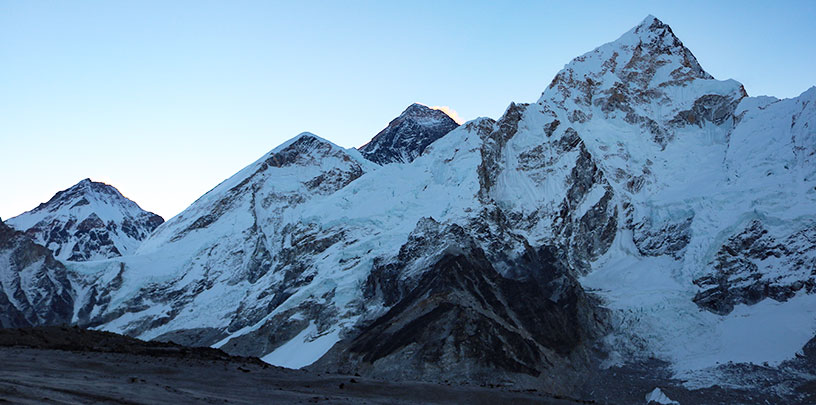How to Deal with Altitude Dangers
Every year, thousands of nature-lovers make their way to Nepal to embark on some of the most beautiful walking tracks the world can offer, and with good reason.
The Himalaya offer terrain to be trekked unlike that you’ll find anywhere else in the world, whether you choose the Everest Base Camp, Annapurna, Mustang or other popular circuits around the nation. The mountains here are magnificent, the peaks precipitous and the beauty breathtaking.
The only issue is, unlike most of the world’s natural beauties, the Himalaya will take your breath away all the time. When you’re sleeping, when you’re eating, walking, talking. Heck, one of the most strenuous activities on the mountain is going to the bathroom.
It’s because there is another factor at play than purely beauty: altitude.
Skip ahead to read:
- Effects of altitude on the body
- Symptoms of altitude sickness
- How dangerous is altitude sickness
- How to protect yourself from acute mountain sickness
Consider protecting your travel plans and trek to Mount Everest Base Camp with Cover-More travel insurance. Get a free quote online for our adventure travel insurance.
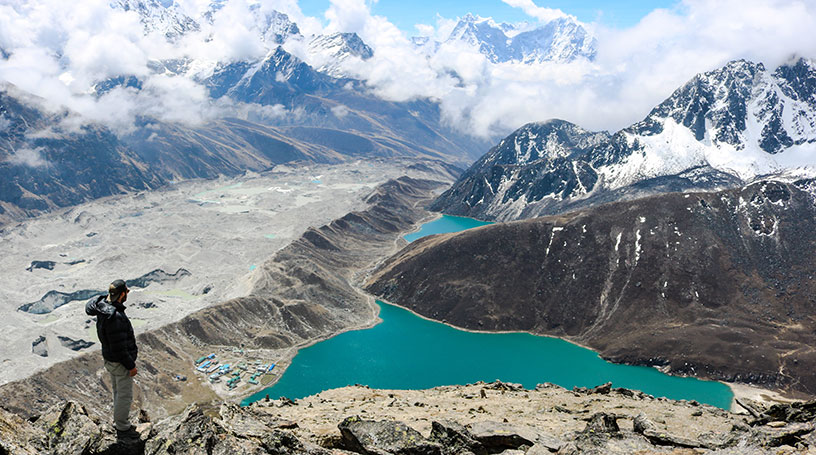
My oh my, the Himalayas aren't short of some incredible views.
Each breath you take at sea level is worth two at this high altitude. The air literally has less oxygen. To your body, at complete rest, you’re doubling your aerobic output compared to sea level.
The question is: what does this do to your body, what are the symptoms, how dangerous can it be, and what can you do to reduce its effects on your body?
Well, here are my tips from having done the trek myself, but keep in mind I am not a medical professional and my tips should not be treated as such. You should check with your doctor and get their advice before undertaking the journey to Mount Everest Base Camp (MEBC).
Hiking to Mount Everest Base Camp is not easy. But it sure is rewarding. Read this account from a fellow travel blogger of her journey to find Mount Everest and what Jess Buchan experienced along the way!
Altitude can have numerous effects on the body, with the key difference being your body is now taking in less oxygen per breath that it’s used to, making it hypoxic. This means each haemoglobin in your red blood cells contains less oxygen, which commonly takes effect to your respiratory and cardiovascular systems.
The most obvious effect of altitude is a reduced aerobic capacity. You will tire and run out of breath earlier than expected. Walking up a hill will leave you feeling as though you’ve just sprinted a 200m effort as your body struggles with the intensity of moving with less oxygen.
People often experience headaches and migraines at high altitudes. As the air begins to drastically thin, the brain begins to suffer from a lack of oxygen. The brain, attempting to remedy the situation, signals the heart to send more blood to the brain. The increased blood flow increases oxygen to the brain, but also drastically increases the volume of blood, causing cerebral swelling and the headaches experienced. This is AMS, the early stages of a condition known as High Altitude Cerebral Edema (HACE).
HACE’s respiratory sibling, High Altitude Pulmonary Edema (HAPE), is less understood medically around the world and not as easily explained in layman’s terms. HAPE involves fluid being let into the lungs at altitude, making it hard to breath and, if left unattended, can result in trekkers and climbers drowning from the inside out, with lungs full of fluid.
Linda McMullen, a Flight Centre Travel Agent, shares her story here about having to be air lifted off Mount Everest due to altitude sickness.
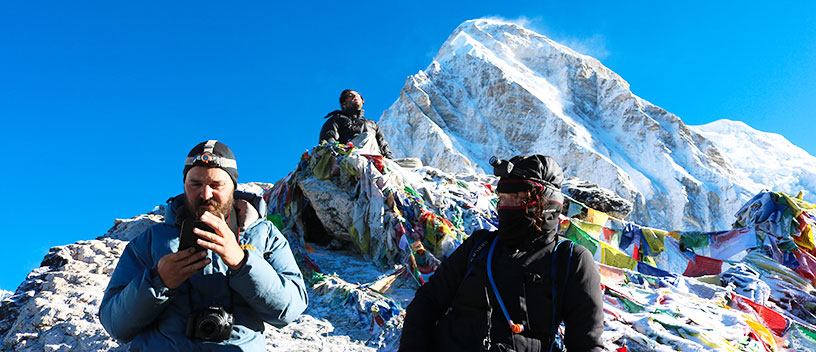
At Kala Pattar, you’re 5,550 meters in the air - the highest point in the trek. It’s a long way up.
AMS (Acute mountain sickness)
- Difficulty sleeping (and waking up short of breath), dizziness, headache, loss of appetite, nausea, rapid pulse and shortness of breath with minor exertions.
HACE (High altitude cerebral edema)
- Early symptoms are similar to severe AMS, and lead to confusion, loss of consciousness, fever and an altered mental state.
HAPE (High altitude pulmonary edema)
- HAPE can occur without any AMS symptoms, though they are often present.
- Coughing, wheezing, blue skin colour, shallow breathing, quickened pulse. One can often hear the liquid in their lungs as they breath.
When you’re this close to Everest (middle, pink cloud), you can count on headaches.
There is a perception that trekking to Everest Base Camp is not a dangerous activity to undertake, and whilst altitude may make life uncomfortable, it’s not going to cause any lasting damage. Let me be clear. That perception is wrong.
Trekkers seem to think that because there are people summiting Mount Everest, a full 3,500m higher than Mount Everest Base Camp (MEBC), the real danger lies further up and not along the path to Base Camp.
The truth is, Everest expeditions take 15-21 days to trek to MEBC, to ensure they are acclimatised when they reach their camp. Most trekking companies send their clients to Base Camp in around 8 days, meaning trekkers have had half the time to acclimatise to an increase in around 4,000 meters in altitude than their climbing counterparts.
This is where the danger lies in trekking.
In 2017, 3 trekkers died of altitude sickness below Base Camp. It’s rare, but if you happen to bisect the line between poor bodily function at altitude and stupidity, you could find yourself in trouble. Once you’re feeling severe symptoms, the only way back to health is in a helicopter back to Kathmandu.
Trek over.
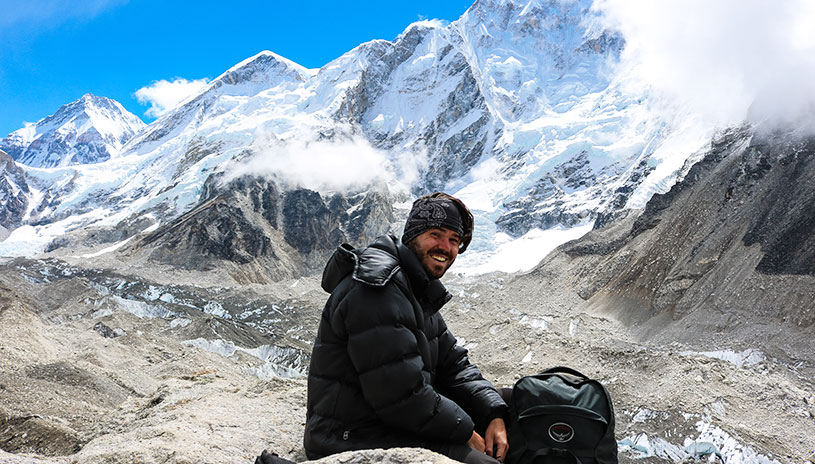
Hidden benefit of an altitude break: You get to do nothing but stare at nature’s jaw dropping beauty.
In saying all this, I can’t stress enough - trekkers who use a little bit of common sense, take a little bit of care and listen to their body will decrease their changes of having an issue.
Check out these travel tips from Lisa Owen, as she shares what you need to know before trekking in Nepal.
There are a number of safeguards you can take to help get yourself to Base Camp:
- Ensure you have a good guide. They should prioritise your health over speed in getting there.
- Once you’ve got a good guide, listen to them. There’s no need to be a hero - the Himalayas will still be there in half an hour.
- Don’t be afraid to take rest days and walk slowly. Guides usually schedule two acclimatisation days. This gets you to MEBC by day 8: still very fast. Don’t be afraid to take an extra day along the way.
- Talk to your doctor about taking Diamox. Taking some in the morning and at night can help speed up the acclimatisation process, and it hasn’t been shown to hide symptoms. It’s important to note that many get sick because they’ve taken Diamox and they think it makes them invulnerable to AMS. It doesn’t so be warned.
- Listen to your body. Some people will get to base camp with nary a headache. You might not. Stop. Take a breath. On our way to base camp, I had to stop as frequently as every five minutes to regain myself, but I knew that’s what I needed and I knew if I pushed, I had a pretty decent chance of ending my trip with a bit of HACE.
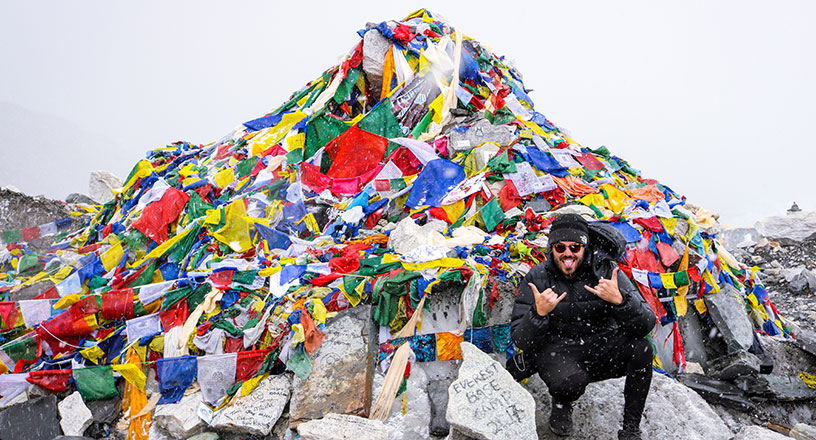
Trying way too hard to look like I really want to be there when really, my head hurts.
By the end of the trek, few people will make it through having avoided all issues of altitude. It is not something that should dictate your entire trek, but it is something all trekkers in the Himalaya do well to be conscious of.
A death below MEBC is a rare case, the combination of both an incompatible body and a series of poor decisions.
However, given most of us don’t know what our body is going to do when it gets there, it’s better to be prepared for the possibilities that await in the beautiful highlands of the mountains.
Get a free quote online for Cover-More's adventure travel insurance.
Michael Kelly is a fairly regular Aussie guy with the yin-and-yang ability to find his way into awkward, weird, thrilling or gross situations. He's been spending the past year in Nepal, traversing the Himalayas and working in Kathmandu. If you'd like to keep up with him, check Michael out on Instagram or visit his website.
The views, opinions and positions expressed by the author and those providing comments are theirs alone, and are meant as travel inspiration only. They do not reflect the opinions of Cover-More Insurance. You should always read the PDS available from your travel insurance provider to understand the limits, exclusions and conditions of your policy and to ensure any activities you undertake are covered by your policy.
Material on this website is provided for informational purposes only. It is general information and discussion about medicine, health and related subjects may not apply to you as an individual, and is not a substitute for your own doctor’s medical care or advice. The words and other content provided on this website, and in any linked materials, are not intended and should not be construed as medical advice. If the reader or any other person has a medical concern, they should consult with an appropriately licensed physician or other health care worker. Nothing contained on the website is intended to establish a physician-patient relationship, to replace the services of a trained physician or health care professional, or otherwise to be a substitute for professional medical advice, diagnosis, or treatment. The views and opinions expressed on this website have no relation to those of any academic, hospital, practice or other institution with which the authors are affiliated. They do not necessarily reflect the opinions of Cover-More Insurance Services Pty Ltd. Never disregard medical advice or delay seeking medical care because of something you have read on or accessed through this website. If you think you may have a medical emergency, call your doctor or emergency services immediately.
